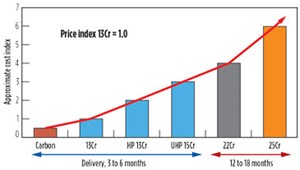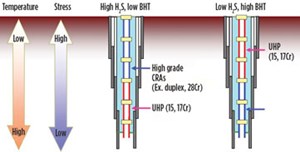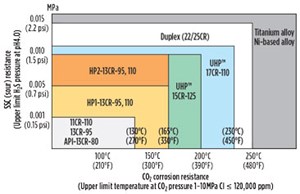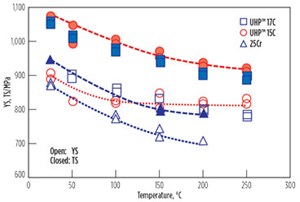High strength alloys and connection options for extreme HPHT wells
Historically, HPHT wells have been defined as operations with pressures in the 10,000-psi-to-15,000-psi range and temperatures in excess of 300°F. But with many operators drilling or planning wells in excess of 20,000 psi and temperatures in excess of 400°F, previous materials and connections no longer meet the requirements to ensure effective well completions and HSE concerns.
The simple solution is to use thicker, heavier tubulars, but there are additional considerations. The effects of temperature degradation on physical material properties, aggressive wellbore environments, and economic considerations add constraints to material selections. Furthermore, once the tubulars are determined, appropriate threaded connections are required to provide ratings up to, or equivalent to, the pipe body, along with validated performance and field installation reliability. All of these conditions must be satisfied while maintaining the most efficient overall solution in terms of delivery and installed cost.
While the pressures and temperatures can be managed with higher material strength and greater wall thickness, the downhole environment can limit which materials are selected. Material suitability should be determined early in the design process. The complete solution process must, therefore, include considerations of not only pressure and temperatures, but sulfide stress cracking (SSC) and corrosion from wellbore and completion fluids.
The use of cold hardened alloys provides the resistance to downhole environments for H2S and CO2, but they are expensive and have long lead times. They also are more greatly affected by temperature and anisotropy than hot finished products. One advantage of cold hardened alloys is the availability in higher yield strengths above 140 KSI. In many cases, the use of higher chromium (Cr) hot finished materials and specialized carbon steels can provide appropriate performances at reduced costs, and with less degradation at higher temperatures.
Ultra-heavy wall pipe (>1-in. wt) and coupling stock (2.5-in. wt) are now available in “mild” sour service carbon steels, martensitic 15Cr and martensitic+ferritic+austenitic 17Cr stainless steels with specified minimum yield strengths (SMYS) up to 125 KSI. The combination of heavier wall thickness and higher yield strength, with proven CO2 and H2S resistance, provides efficient engineering options for ultra-HPHT wells.
MATERIAL SELECTION
Early in the design phase, material screening and selection should be performed. Optimized dimensions and yield strengths can provide higher pressure and strength performance, but the suitability of the material for the downhole environment is a critical path issue. It would be of little value to determine the required pipe dimensions and yield strengths, only to ascertain that the material grade(s) required cannot be produced in the needed dimensions. The selected material must be capable of withstanding the wellbore environmental conditions, as well as exposure to completion/packer fluids.
The presence and combinations of H2S, CO2, chlorides, pH, and temperature over the life of the well determine the suitability of particular material grades. Increased temperatures aid in SSC resistance but escalate stress corrosion cracking and CO2 corrosion attack (up to 300°F). SSC resistance should be considered at the lowest possible temperature which is normally shut-in temperatures at, or near, the surface, while the highest expected temperature is critical for CO2 corrosion attack.
The material selection process should result in the lowest-cost, reliable solution possible. The cost of the material depends greatly on chemistry and the manufacturing process. Carbon steel has the lowest cost, but it presents the greatest risk. Duplex or nickel alloys can resist highly corrosive environments, but the costs are the highest and delivery time is the longest. The key is to determine the material that fully meets the requirements at the lowest cost and shortest delivery time, Fig. 1.
The known and unknown parameters, and their combined effects due to pressure and temperature, are complex. So, the final material selection should be determined with materials and application specialists. The initial analysis also should include considerations for H2S, CO2, and pH. While well conditions change, depending on depth, pressures and temperatures, a general material selection methodology is outlined below:
- Below 3-psi partial pressure CO2, carbon steels are applicable in terms of SSC and corrosion.
- Above 3 psi, CO2, and up to 1.5 psi partial pressure H2S, hot finished Cr products can be used.
- At partial pressures above 3 psi CO2 and 1.5 H2S, cold hardened alloys are required.
An innovative method that can increase overall efficiencies is the use of a mixed-material string. Depending on temperatures and conditions, it might be possible to use a mixed-material string, where a higher-strength material is used in a challenging section of the well, and a less-expensive material is used in less-demanding portions of the string. Mixed strings can provide the required material performances while reducing overall costs, Fig. 2.
SOUR SERVICE
Sour service is defined as applications greater than 0.5 psi H2S, partial pressure, but the total sour service severity is a function of partial pressure of H2S, temperature and pH.
Carbon steels. For the National Association of Corrosion Engineers (NACE) Regions 1 and 2, and somewhat in Region 3, carbon steels are available up to 125 KSI SMYS. For severe sour service in NACE Region 3, yield strengths are generally limited to 110 KSI for carbon steels. Heavy wall carbon steel materials (up to 1.3-in. wt) in 125 KSI have been qualified for sour service in NACE Region 3, up to 7-psi H2S at pH 4.0. In these conditions, coupling stock was also qualified with a wall thickness of 2.4 in. In the absence of CO2, carbon steels can be manufactured and used in the ultra-heavy walls necessary to complete ultra-HPHT wells.
Hot, finished Cr materials. Where some H2S is present along with CO2, hot finished stainless steels, such as 13Cr, 15Cr, and 17Cr, are attractive alternatives. Available up to 125KSI, these materials give good corrosion resistance and less yield strength degradation at higher temperatures than cold finished materials. Costs are lower, and deliveries are better than cold hardened alloys, as well. Tie-back casing strings have been run successfully in wall thickness up to 1.35-in. and 125,000-psi yield strength.
Cold worked materials. Duplex (22Cr), super duplex (25Cr) and Ni alloys offer the highest performance for SSC and corrosion attack, but they are expensive and can be difficult to obtain in larger ODs, Fig. 3. Processing, handling and running are more difficult with these materials, as well. In general, where these materials are the only viable solution, they are the obvious choice, but other options with full or mixed strings should be considered.
INCREASING MECHANICAL PERFORMANCE
The fundamental variables for tubular performance are OD, wall thickness and yield strength. The constraints for OD and wall thickness are functions of clearance for the OD and required drift or inner clearance for the ID. These constraints can produce non-standard tubular sizes.
Internal pressure. Internal yield pressures are calculated conventionally with Barlow’s equation (PYield = 2σt/OD) multiplied by a factor representing the minimum allowable wall thickness (0.875, 0.9). Increasing the guaranteed minimum wall thickness tolerance can improve internal pressure ratings. It may be possible to order tubulars with 90%, 92.5%, or even 95% minimum wall thickness guaranteed. While each increment increases the internal yield pressure by only 2.5%, this could make the difference in meeting the design criteria. Most manufacturers can produce 90% minimum wall pipe with negligible impact on cost or deliverability. But as the guaranteed minimum wall thickness increases, manufacturing costs also increase.
In some cases, it might be possible to order tubulars with a certain percentage guaranteed to meet the higher wall thickness. For example, for a given casing order, at least 50% of the order must meet 92.5% minimum wall thickness with the remainder meeting 90% wall thickness. With the use of wall mapping and advanced inspection equipment, the manufacturer can identify and report the minimum wall on each length. The user can place the lengths within the string, based on the well loads and delivered pipe condition.
When higher minimum wall thickness is ordered, special attention should be given to meeting the drifting requirements. The OD tolerance can be shifted or relaxed to aid in maintaining drift constraints. While a gain of 2.5% or 5% minimum wall may not initially seem significant, the increase of pressure ratings can be 500 to 1,000 psi for 90% minimum wall and up in the range of 1,000 psi to 2,000 psi for 92.5% min wall. The increased pressure ratings can make some projects viable and can be worth the additional costs.
Collapse pressure. Tubulars for ultra-HPHT wells are normally thicker walls with larger D/t ratios and the conventional API collapse equations give sufficiently high collapse ratings. But there are cases, such as annular pressure buildup, salt and subsalt formations where higher than API collapse performance is required. Manufacturers offer proprietary “high collapse” grades that provide higher than API collapse and may be the enabling technology to meet the design factor requirements for an ultra-HPHT well. Higher collapse values can be obtained through higher aiming wall thickness, controlling the minimum yield strength, and mill manufacturing processes.
The manufacturer should have a sufficiently vetted methodology for determining the collapse rating and, where necessary, a procedure for validating the ratings with physical collapse testing in accordance with published standards. High collapse grades often utilize higher minimum yield strengths and with the higher yield strength, any suitability for sour or mild sour service should be confirmed.
Additional considerations. To achieve the higher performances required for ultra HPHT applications, the combinations of heavier wall thickness and non-standard OD’s can make it difficult to accommodate the required ID drift. Yield strength degradation at the extreme temperatures associated with ultra-HPHT applications impacts the overall performance of installed tubulars and equipment. Internal pressure, collapse, and joint strength are all affected by the reduction of yield strength at elevated temperatures. For carbon and hot finished quenched and tempered materials, the common derating factor is –3%/100°F above ambient. Cold hardened products generally have a higher derating, roughly twice that of hot finished products. At extreme temperatures (450°F), this can result in over 10% yield strength derating for hot finished, and over 20% for cold hardened materials, Fig. 4.
THREADED CONNECTIONS
Lastly, threaded connections should be considered. In general, three types of connections exist: 1) true flush connections, where the pin and box ends are threaded directly on the pipes; 2) semi-flush connections, where the box ends are expanded and stress relieved; and 3) conventional threaded and coupled connections. Flush connections provide the greatest clearance, semi-flush are close to flush, and threaded and coupled require the most clearance. For non-standard pipes, premium connections can be tailored to match the pipe properties.
Flush connections (F) with lower joint strength can be an option, where string lengths are shorter and the connection can support the string length with appropriate design safety factors. For Cr and corrosion-resistant alloys (CRA), materials phosphating is not an option, and applying a surface treatment, such as copper plating, is difficult.
Semi-flush connections (SF) can work for carbon steels, but the ability to swage and expand, stress-relieve the pipe ends on heavy wall tubulars could be an issue on cold worked CRA materials. Again, surface treatment of the threaded ends is difficult. In the case of sour service materials, the SSC performance of the stress-relieved pipe ends should be confirmed.
Threaded and coupled connections (T&C) are typically preferred for ultra-heavy wall pipes for several reasons. T&C connections can provide full pipe body joint strength and the capability to run long strings. The couplings can be manufactured separately and all options for surface treatment, including electro plating and proprietary anti-galling coatings are available. Extra-heavy wall coupling stock with proven material performance and through-wall properties is available for heavy wall T&C connections, even in higher Cr and CRA grades. T&C connections also can be run with conventional lifting equipment on the rig. Optimized connection designs with improved running performance are available for heavy wall connections.
IMPROVING ULTRA HPHT ECOMOMICS
With advances in material grades and rolling technology, greater options exist for completing ultra-HPHT wells. A thorough understanding of material performances and dimensional options is necessary to select the optimum tubulars for ultra-HPHT completions. Although this can be a time-consuming, iterative process, early research and discussions to determine available options can result in safe, reliable tubular products at the most efficient cost, Fig. 5. ![]()
ACKNOWLEDGEMENT
The author wishes to thank JFE Steel and Marubeni Itochu Tubulars for their support in the production of this article.
- Using data to create new completion efficiencies (February 2024)
- Digital completions platform provides complete operations visibility to enhance efficiency, collaboration (December 2023)
- Delivering a full range of innovative well completion technologies (September 2023)
- Combining video and ultrasound increases downhole data capture accuracy (May 2023)
- Exploring annular phase separation phenomena to optimize AICD completion design, to control unwanted effluents (May 2022)
- Using data from drilling to guide completion designs (May 2022)







